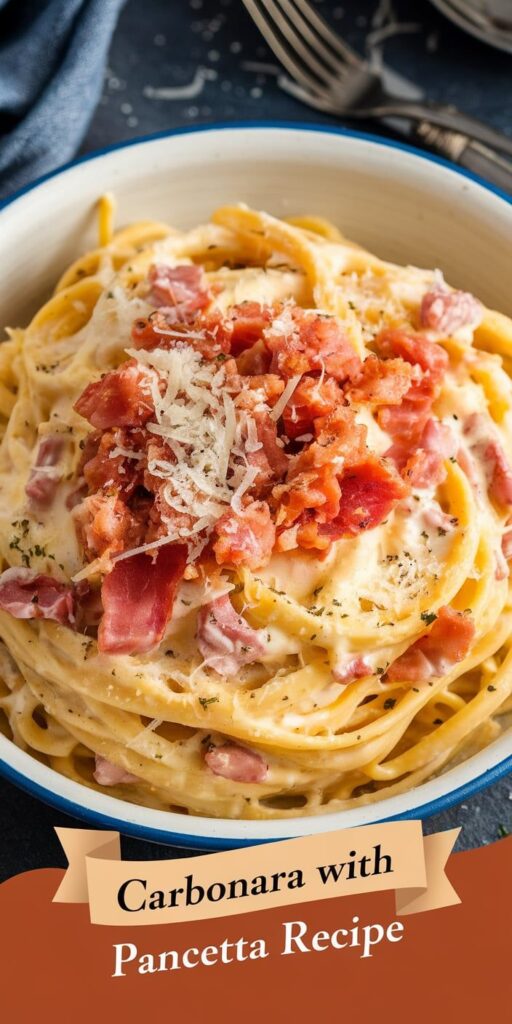Discover the magic of traditional carbonara, a beloved Roman specialty that transforms simple ingredients into a culinary masterpiece. This iconic Italian cuisine celebrates the rich, creamy sauce that makes pasta dishes truly unforgettable.
Carbonara represents the heart of authentic Italian cooking—an egg-based pasta that combines simplicity with incredible depth of flavor. From the bustling streets of Rome to kitchens worldwide, this classic dish continues to captivate food lovers with its elegant preparation and luxurious taste.
Crafted with precision and passion, carbonara showcases how a few quality ingredients can create an extraordinary dining experience. Each bite tells a story of generations of Italian culinary tradition, inviting home cooks to explore the art of perfect pasta preparation.
Our recipe will guide you through creating an authentic carbonara that captures the true essence of Italian gastronomy. Get ready to transform basic ingredients into a restaurant-worthy meal that will impress family and friends.
What Makes Authentic Carbonara with Pancetta Special
Dive into the heart of Roman cuisine, where Carbonara stands as a culinary masterpiece that captures the essence of traditional Italian cooking. This iconic pasta dish represents more than just a meal—it’s a celebration of simple yet extraordinary flavors that have been perfected over generations.
Origins of Traditional Carbonara
The roots of Carbonara stretch deep into the rich culinary landscape of Rome. While its exact origin remains shrouded in mystery, food historians believe the dish emerged in the mid-20th century. Some theories link it to charcoal workers (carbonari) who needed hearty, easy-to-prepare meals during long workdays.
Why Pancetta is the Perfect Choice
Pancetta, a type of cured pork, brings an unparalleled depth of flavor to authentic Carbonara. Unlike other meats, pancetta provides a rich, salty essence that perfectly complements the creamy egg yolks and sharp Pecorino Romano cheese.
Key Elements of Classic Carbonara
- Guanciale or pancetta as the primary meat component
- Fresh egg yolks for creating a silky texture
- Pecorino Romano cheese for sharp, tangy notes
- Freshly ground black pepper for a spicy kick
| Ingredient | Role in Carbonara | Authentic Requirement |
|---|---|---|
| Pancetta | Provides fat and flavor | Essential |
| Egg Yolks | Creates creamy sauce | No cream allowed |
| Pecorino Romano | Adds sharp cheese flavor | Mandatory |
| Black Pepper | Adds spicy complexity | Freshly ground |
Understanding these core principles ensures you’ll create a Carbonara that truly honors its Roman heritage—a dish that is simplicity and sophistication embodied on a plate.
Essential Ingredients for Carbonara with Pancetta Recipe
Creating an authentic carbonara requires carefully selected ingredients that capture the essence of traditional Italian cuisine. The magic of this classic dish lies in its simple yet high-quality components.

The foundation of an exceptional carbonara starts with premium spaghetti. Choose a high-quality pasta that can hold the rich, creamy sauce perfectly. Authentic Italian spaghetti ensures the best texture and flavor absorption.
- Spaghetti: Select bronze-cut pasta for optimal sauce adhesion
- Pancetta: Cubed, high-quality Italian cured pork belly
- Eggs: Fresh, room-temperature large eggs
- Pecorino Romano cheese: Aged sheep’s milk cheese
- Parmigiano-Reggiano: Aged cow’s milk cheese for depth
- Black pepper: Freshly ground, coarsely crushed
- Olive oil: Extra virgin, cold-pressed
The combination of Pecorino Romano and Parmigiano-Reggiano creates a complex, nutty flavor profile that elevates the carbonara. Freshly ground black pepper adds a sharp, aromatic kick that complements the rich pancetta.
Selecting high-quality olive oil is crucial for sautéing the pancetta. The oil should be extra virgin, providing a subtle fruity undertone that enhances the overall dish without overpowering the delicate flavors.
Your ingredient selection determines the authenticity and deliciousness of the final carbonara. Invest in the best quality components you can find to create a truly memorable Italian pasta experience.
Step-by-Step Cooking Instructions
Start your pasta preparation by bringing a large pot of salted water to a rolling boil. Select high-quality spaghetti or linguine for the best results. The key to perfect carbonara lies in achieving an al dente texture, which means cooking the pasta until it’s firm to the bite but not hard.
Begin the pancetta rendering process by cutting the meat into small cubes and cooking them in a large skillet over medium heat. The goal is to create crispy, golden-brown pieces that will release rich, savory fat. Drain excess grease, leaving just enough to coat the pan and provide depth of flavor for your sauce technique.
Egg tempering is crucial for creating a creamy consistency without scrambling. Whisk room-temperature eggs with grated Pecorino Romano cheese in a separate bowl. When the pasta is nearly done, carefully add a small amount of hot pasta water to the egg mixture, stirring constantly. This technique helps prevent the eggs from curdling and ensures a smooth, silky sauce.
The final step brings everything together. Drain the pasta, reserving a cup of pasta water. Quickly toss the hot pasta with the rendered pancetta, then immediately mix in the tempered egg sauce. The residual heat will gently cook the eggs, creating a luxurious, creamy coating. If needed, add a splash of reserved pasta water to achieve the perfect consistency. Serve immediately with an extra sprinkle of cheese.





